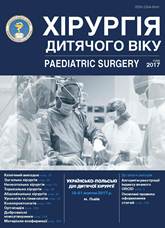Treatment of chemical burns of the esophagus in children
DOI:
https://doi.org/10.15574/PS.2017.56.54Keywords:
chemical burns of the esophagus, bougienage, treatment, childrenAbstract
Objective. To study the treatment efficacy of chemical burns of the esophagus in children with different grades of lesion.Material and methods. For the last seven years in Dnipropetrovsk Regional Children’s Clinical Hospital there were 192 children on treatment with a diagnosis of chemical burn of the esophagus, out of them 108 (56.25%) boys and 84 (43.75%) girls, and prevailed children aged 1-3 years who made up 102 (53.1%). Among damaging agents caused esophageal burns were more often caustic ones 95 (49.47%). In most cases, there was grade II of lesion of esophageal burns in 71 (36.98%) children. Treatment of post-burn esophagitis includes detoxification, stomach lavage, pain management, antibiotic therapy, short course of corticosteroids. Estimation of the patient’s status provided during the first twenty-four hours. Further the restoration of esophageal patency was conducted with the use of instrumental methods of treatment. The main method of corrosive strictures of esophagus was gullet bougienage and dilation.
Results. The patients of the study group were treated using bougie over guidewire dilators. Application of this methodology in treatment of patients with the esophageal burns allowed considerably reduce the amount of cicatrical esophageal stenosis, as well as such complications as perforations and mediastinitis.
Conclusion. Proper provision of primary care and the selection of correct diagnostic and treatment tactics of patients with chemical burns of the esophagus helps to reduce complications and disability in children with this pathology.
References
Alekseenko SI.2006). Chemical burns of the esophagus in children «Child's surgery» Saint Petersburg: 20.
Krivchenia DU, Dubrovin AG, Andreeshev SA. (2008). Diagnostics and treatment of stenosis of gullet for children. Kiev: 182.
Makarova OL, Korolev МP, Fedotov LЕ. (2003). Tactics of treatment of patients with plural cicatrical by stenosises of gullet and stomach after chemical burns, Ukrainian magazine of littleinvasion and endoscopic surgery 3; 7: 39-40.
Ferry GD, Fishman DS, Jensen C, Hoppin AG. (2013). Caustic esophageal injury in children. www.uptodate.com.
Sakineh Fallahi, Seyed MV. (2012). Hosseini Soghra Fallahi, Morteza Salimi, Ali Akbar Hesam, Seydeh Hamideh Hoseini. Extent of Injury of Gastrointestinal tract due to accidental ingestion of chemicals among children at Bandar Abbass Children Hospital 2009–2011. Life Science Journal. 9(4): 2054–2057.
Downloads
Issue
Section
License
The policy of the Journal “PAEDIATRIC SURGERY. UKRAINE” is compatible with the vast majority of funders' of open access and self-archiving policies. The journal provides immediate open access route being convinced that everyone – not only scientists - can benefit from research results, and publishes articles exclusively under open access distribution, with a Creative Commons Attribution-Noncommercial 4.0 international license(СС BY-NC).
Authors transfer the copyright to the Journal “PAEDIATRIC SURGERY.UKRAINE” when the manuscript is accepted for publication. Authors declare that this manuscript has not been published nor is under simultaneous consideration for publication elsewhere. After publication, the articles become freely available on-line to the public.
Readers have the right to use, distribute, and reproduce articles in any medium, provided the articles and the journal are properly cited.
The use of published materials for commercial purposes is strongly prohibited.

